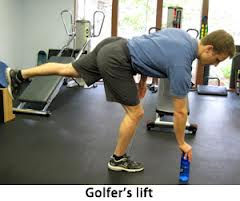The NIOSH Risk Factors for Low Back Disorder
Are you at an elevated risk of lower back disorder? The National Institute for Occupational Safety and Health (NIOSH) released a list of risk factors. They are as follows:
1. Seated or static work postures
2. Frequent trunk movement particularly rotation
3. Frequent lifting, pushing, pulling activities
4. Seated whole body vibration (truck driver)
5. Repetitive lumbar full flexion
6. Time frame of performing the activity (how long after arising from bed)
Possible Solutions:
1. Frequently change positions. Get up and walk around a few minutes. Stretch by reaching for the ceiling
2. Avoid rotating the trunk if possible and pivot on your toes in order to turn your entire body in the direction of your activity
3. Lift, pull, push with proper mechanics
4. Avoid full lumbar flexion. Use your legs in order to squat to get to a lower position
5. Do not begin these activities until you have been out of bed for at least 30 minutes-1 hour.
Your goal is to remove the stressors and enhance the activities that build support/stability



















